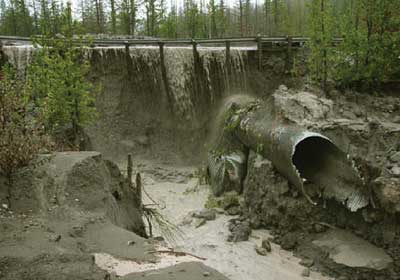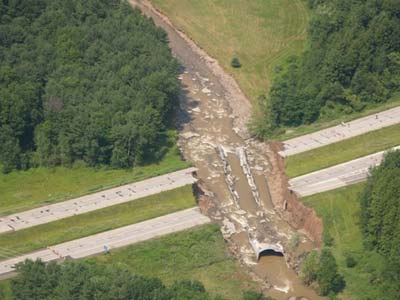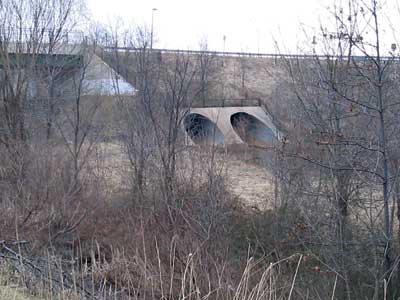Transportation Asset Management Case Studies
CMS Case Study
Note From the Associate Administrator
The need for better culvert management is apparent.
With factors such as an aging and deteriorating national infrastructure, increasing congestion, highway safety challenges, and limited funds weighing heavily on transportation agencies, State departments of transportation are looking for innovative ways to manage their transportation dollars.
One tool that is providing great benefits is Transportation Asset Management (TAM), a strategic approach that strives to provide the best return for each dollar invested by maximizing system performance, improving customer satisfaction, and minimizing life-cycle costs.
TAM implementation varies from State to State and includes the areas of bridge and pavement management, highway safety and operations, data integration, economics in asset management, life-cycle cost analysis, and network preservation, among others. TAM is also beginning to include often overlooked highway features such as sign structures, culverts, and retaining walls.
Because each State's experience is unique-and because the Federal Highway Administration believes that transportation agencies work more efficiently when information on one another's successes is shared-the Office of Asset Management is continuing its series of TAM case study reports begun in 2002.
On behalf of the Office of Asset Management, I am pleased to present this case study on culvert management systems (CMSs). Although sometimes included as part of bridge management systems, culverts are not always given the attention they require. This case study details the efforts and methods of three States and one local agency in implementing a CMS. I believe that this and other case studies generated by the Office of Asset Management will help transportation agencies meet the increasingly complex challenges facing them today.
King W. Gee
Associate Administrator for Infrastructure
May 2007
Note to the Reader
The Transportation Asset Management Case Study series is the result of a partnership between State departments of transportation (DOTs) and the Federal Highway Administration (FHWA) Office of Asset Management. FHWA provides the forum from which to share information, and the individual States provide the details of their experiences. For each case study report, FHWA interviewed State transportation staff, and the resulting material was approved by the State. As such, the reports rely on the agencies' own assessment of their experience. Readers should note that the reported results may or may not be reproducible in other organizations.
Because of their potential for catastrophic failure, culverts require careful management.
Executive Summary
State and local DOTs are responsible for a large number of highway assets. Many of these assets, such as bridges and pavements, are highly visible and have dedicated management systems. Highway agencies also have many less noticeable structures, such as culverts, that tend to go ignored until a catastrophic failure occurs. Unfortunately, several catastrophic failures have occurred across the United States, emphasizing the need for a culvert management system (CMS). Some States have utilized the CMS program developed by FHWA, while other States have created in-house programs to meet the specific needs of their area.
By taking a proactive role in managing culverts, States are preserving their investment in the transportation infrastructure and providing a safer roadway for the traveling public. Maryland, Minnesota, Alabama, and Shelby County (located in Alabama) use different methods to manage their culverts. This study explores their methods and offers information to agencies seeking new approaches to culvert management.
Maryland has divided the responsibility for its culverts based on size. Large culverts are the responsibility of Maryland's bridge unit, while small culverts are under the auspices of the State's roadway unit. Although Maryland no longer utilizes Pontis (a comprehensive bridge management system [BMS] tool), it applies the condition ratings from Pontis to its own in-house CMS for large culverts. Maryland has also developed a risk-based approach to selecting which structures receive priority for inspections, which helps to reduce inspection costs. For the smaller structures, the roadway unit uses a separate in-house inspection and rating system that incorporates geographic information system (GIS) tools.
Like Maryland, the Minnesota DOT divides the responsibility for its culverts between the bridge hydraulics unit and the roadway unit based on the size of the culverts. However, unlike Maryland, Minnesota uses Pontis along with element-level condition ratings to manage the larger culverts. The bridge hydraulics unit has developed an in-house GIS-based program called HYDINFRA, which is used for culverts and other types of drainage features, such as drop inlets. The bridge hydraulics unit has also developed an inspection guide complete with condition rating language for use with HYDINFRA.
In Alabama, the DOT's maintenance bureau manages the State's culverts, and maintenance personnel inspect these structures on an as-needed basis. The current maintenance management system is scheduled to be updated in the near future, which could provide an excellent opportunity to develop an in-house system or commence use of a formal CMS.

Typically, Asset Management case studies focus on the activities of State DOTs rather than local agencies. However, the Shelby County Highway Department was found to have a very proactive approach to culvert management. While the county's inventory is not as large as that of a State DOT, Shelby County uses the FHWA CMS program. Shelby County has been a leader in the State of Alabama in promoting Asset Management on a county level and educating other counties using the program. Shelby County DOT has taken the initiative to partner with academia and industry and has utilized Asset Management principles to help determine budget and replacement priorities for highway structures in this fast-growing county.
This overview of the culvert management practices used by these DOTs is presented to show the importance of managing these drainage structures. It is also intended to help other State and local DOTs formulate and shape their Asset Management programs in ways that lead them to achieve their goals and performance measures efficiently and cost-effectively.

